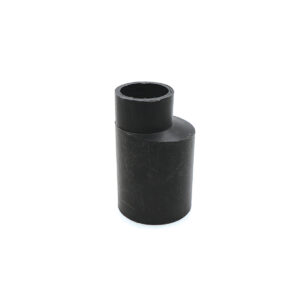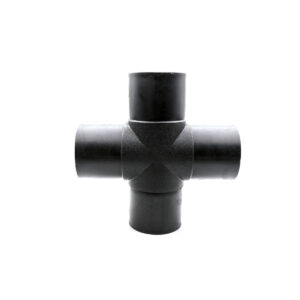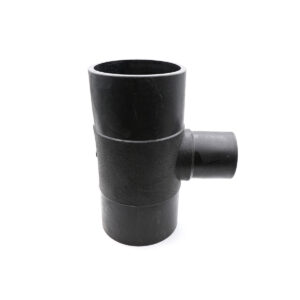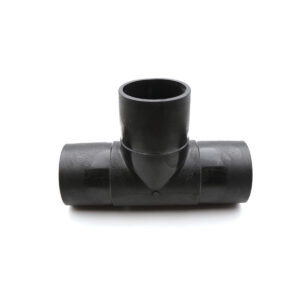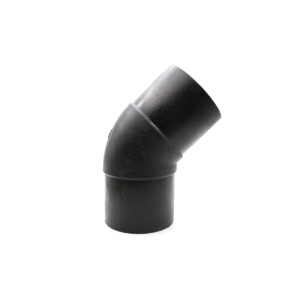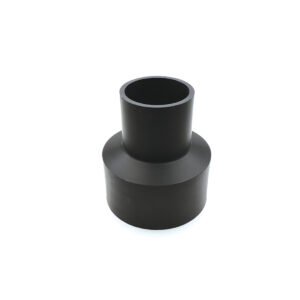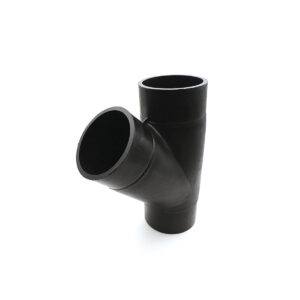High-pressure piping networks have long required fittings that, in addition to withstanding hydraulic and mechanical stresses, remain resistant to corrosion and degradation. High-pressure polyethylene fittings, produced from advanced PE100 or PE100-RC grades, have precisely met this need and now replace traditional metal fittings in many industries. The following, with a comprehensive approach beyond mere rewriting, examines every aspect of this family of fittings—from design and raw materials to test standards and installation details—so it can serve as a reference for engineers, contractors, and procurement managers.
Technical and Chemical Properties of High-Pressure Grade Polyethylene
The polyethylene used in high-pressure piping typically has medium to high molecular weight, and its formulation incorporates 2 to 2.5% carbon black for ultraviolet protection. This carbon black is dispersed uniformly in the polymer matrix to prevent stress concentrations, environmental stress cracking (ESC), and premature loss of strength. Solid- and liquid-phase antioxidants are also essential to suppress radical chains generated by oxidation at processing temperatures above 200 °C. The result is a material with:
- Allowable stress limit of 8–10 MPa at 20 °C for at least 50 years of service,
- Minimum Required Strength (MRS) ≥ 10 MPa,
- Adequate toughness down to −40 °C, and
-
Allowable long-term strain of about 5% to prevent creep.
Standard Classification and Design Codes
ISO 4427-3, EN 12201-3: specify dimensional requirements and production tolerances for molded or machined fittings.
DIN 8076-3: defines burst and cyclic pressure test parameters for butt-welded fittings.
GIS/PL2-4 (specific to UK gas networks): states additional requirements for resistance to Rapid Crack Propagation (RCP) in electrofusion couplers.
Strict adherence to these standards ensures that the installed fitting is at least as strong as the adjacent pipe and that the network’s fifty-year design life is achieved without reducing the safety factor.
Manufacturing Processes and Quality Control
Injection Molding (Injection Molding)
- Suitable for diameters up to 400 mm;
- Mold back pressure 80–120 MPa and melt temperature 210–240 °C;
- Use of hot-runner systems for uniform melt distribution and void prevention.
Fabricated Mitred Fittings (Fabricated Mitred Fittings)
- Cutting pieces from extruded pipe and butt-welding at desired angles or forms;
- Non-destructive testing (NDT) of welds using macro-section test and inline ultrasonic inspection.
Electrofusion (Electrofusion)
- Electric welding with specific energy of 40–60 kJ/m²;
- Barcode marking on each piece for automatic transfer of welding parameters to the control unit.
Response to Dynamic and Thermal Loads
The low density of polyethylene (≈ 0.95 g/cm³) allows fittings to absorb more energy before failure under sudden impacts. Charpy testing on V-notched specimens shows that at −20 °C the fracture energy still exceeds 15 kJ/m²—a value many carbon-steel alloys do not reach at the same temperature. The coefficient of linear thermal expansion of 1.5 × 10⁻⁴ K⁻¹ also requires correct calculation of spacing between fixed restraints (Anchor Blocks) in long buried lines to restrain thermal forces.
Table 1 — Relative chemical resistance of polyethylene compared with stainless steel 304 and PVC-U
| Corrosive medium | PE100 (23 °C) | Stainless Steel 304 (23 °C) | PVC-U (23 °C) |
|---|---|---|---|
| Sulfuric acid 20% | A (fully resistant) | B (moderate resistance) | C (not resistant) |
| Chlorine solution 100 ppm | A | C (pitting attack) | B |
| Sodium hydroxide 30% | A | B | B |
| Aromatic hydrocarbon (toluene) | C | A | C |
A = no significant effect; B = limited change; C = severe attack or dissolution.
Installation Requirements and Pre-Commissioning Tests
- Scraping and cleaning: remove at least 0.2 mm from the pipe’s outer surface before electrofusion.
- Alignment: the allowable angular deviation between pipe ends must not exceed 1.5°; greater misalignment induces additional shear stress on the weld.
- Zero-pressure cooling: after completing the heating cycle, the coupler must cool at ambient temperature without hydraulic pressure for at least 10 min + 1 min/mm of wall thickness.
- Hydrostatic test: routine 1.5 × PN for 2 hours with allowable pressure drop ≤ 3%. In addition, a pulsating cycle 0 → PN → 0 with 30 repetitions is recommended to simulate pump shocks.
Table 2 — Maximum allowable spacing between fixed restraints for buried PE100 pipe–fitting assemblies
| Outside diameter (mm) | PN10 (m) | PN16 (m) | PN20 (m) |
|---|---|---|---|
| 110 | 60 | 45 | 35 |
| 160 | 45 | 35 | 28 |
| 250 | 30 | 22 | 18 |
| 400 | 20 | 15 | 12 |
Values are based on fluid at 20 °C and moist loam soil with friction coefficient 0.35; reduction factors should be applied for higher temperatures or sandy soil.
Repair Considerations and Periodic Inspection
In gas transmission networks, helium tracer testing of electrofusion joints during annual inspections is common. For water lines with diameters above 315 mm, the hydrophone acoustic technique is recommended to detect micro-leaks. The wave speed in polyethylene is about 900 m/s; therefore, the spacing of vibration sensing systems must be designed so that the detection frequency remains above 1 kHz to maintain sensitivity.
The Role of Polyethylene Fittings in Hybrid Network Architectures
Modern projects often adopt “Hybrid Piping”: low-pressure gravity lines made of double-wall polyethylene, medium-pressure lines of PVC-O or coated ductile iron, and high-pressure and strategic lines of high-pressure polyethylene or API steel. In this structure, polyethylene flanged fittings act as transition gateways between plastic and metal systems, and when an internal steel stiffener ring is used, bolt torque can be increased up to 60 N·m without risking crushing the polymer flange.
Tamam Baha Services and Competitive Advantage
As an experienced supplier of high-pressure polyethylene fittings, Tamam Baha Trading Group provides reputable domestic and international brands in the PN10 to PN25 classes, along with pre-purchase technical support, preparation of Welding Procedure Specifications (WPS), and dispatch of on-site supervision teams during installation. Supported by extensive stock in sizes 20 to 630 mm, the company helps minimize project downtime for clients across the Middle East and Europe, and by providing raw-material certificates of origin and Mill Test Certificates it reduces operational risk in high-pressure networks.


